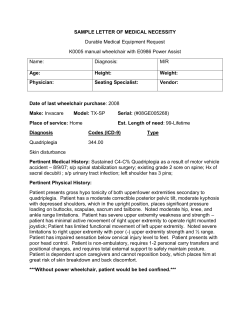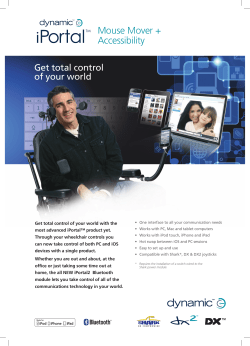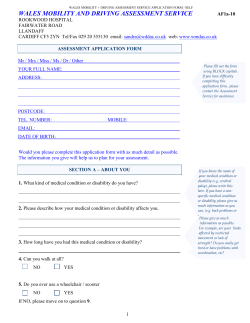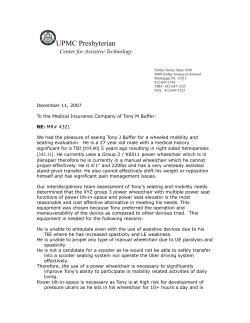
Manual Wheelchair Bases MANUAL WHEELCHAIR BASES
MANUAL WHEELCHAIR BASES Manual Wheelchair Bases Adopted from the National Government Services website. For any item to be covered by The Health Plan, it must: 1. Be eligible for a defined Medicare or Health Plan benefit category 2. Be reasonable and necessary for the diagnosis or treatment of an illness or injury or to improve the functioning of a malformed body member 3. Meet all other applicable Medicare and/or Health Plan statutory and regulatory requirements For the items addressed in this medical policy, the criteria for "reasonable and necessary" are defined by the following indications and limitations of coverage and/or medical necessity. Please refer to individual product lines certificates of coverage for possible exclusions of benefit. For an item to be covered by The Health Plan, the supplier must receive a written, signed, and dated order before a claim is submitted to The Health Plan. If the supplier bills for an item addressed in this policy without first receiving the completed order, the item will be denied as not reasonable and necessary. Suppliers are to follow The Health Plan requirements for precertification as applicable. Manual wheelchair bases require precertification and a physician’s face-to-face. CMS National Coverage Policy DME Region LCD Covers Revision Effective Date The Health Plan CMS Pub. 100-3, Medicare National Coverage Determinations Manual, Chapter 1, Section 280.3 Jurisdiction B For services performed on or after 10/31/13 All plans will follow Oversight Region V Coverage Determination posted on the National Government Services website unless otherwise indicate in sections of this policy or contractual agreements DESCRIPTION A wheelchair is a device used for mobility by people for whom walking is difficult or impossible, due to illness or disability. It typically consists of a seat supported on two large wheels on an axle attached towards the back of the seat and two small wheels near the feet, though there are often small additional features to prevent toppling or to assist mounting curbs. The person moves by pushing with his/her hands circular bars on the outside of the large wheels with a diameter that is slightly less than that of the wheels, or by actuating motors, usually with a joystick. DME Medical Policies | healthplan.org Page 1 MANUAL WHEELCHAIR BASES COVERAGE GUIDELINES A manual wheelchair is covered if: A. The member has a mobility limitation that significantly impairs his/her ability to participate in one or more mobility-related activities of daily living (MRADL) such as toileting, feeding, dressing, grooming, and bathing in customary locations in the home. A mobility limitation is one that: B. C. D. E. F. G. 1. Prevents the member from accomplishing an MRADL entirely, or 2. Places the member at reasonably determined heightened risk of morbidity or mortality secondary to the attempts to perform an MRADL; or 3. Prevents the member from completing an MRADL within a reasonable time frame. The member’s mobility limitation cannot be sufficiently resolved by the use of an appropriately fitted cane or walker, and The member’s home provides adequate access between rooms, maneuvering space, and surfaces for use of the manual wheelchair that is provided, and Use of a manual wheelchair will significantly improve the member’s ability to participate in MRADL and the member will use it on a regular basis in the home, and The member has not expressed an unwillingness to use the manual wheelchair that is provided in the home, and The member has sufficient upper extremity function and other physical and mental capabilities needed to safely self-propel the manual wheelchair that is provided in the home during a typical day. (Limitations of strength, endurance, range of motion, or coordination, presence of pain, or deformity or absence of one or both upper extremities are relevant to the assessment of upper extremity function.) Or, The member has a caregiver who is available, willing, and able to provide assistance with the wheelchair. If the manual wheelchair will be used inside the home and the coverage criteria are not met, it will be denied as not reasonable and necessary. ADDITIONAL COVERAGE GUIDELINES FOR MANUAL WHEELCHAIRS A standard hemi-wheelchair (K0002) is covered when the member requires a lower seat height (17" to 18") because of short stature or to enable the member to place his/her feet on the ground for propulsion. A lightweight wheelchair (K0003) is covered when a member: a) Cannot self-propel in a standard wheelchair in the home; and b) The member can and does self-propel in a lightweight wheelchair. A high strength lightweight wheelchair (K0004) is covered when a member meets the criteria in 1 and/or 2: DME Medical Policies | healthplan.org Page 2 MANUAL WHEELCHAIR BASES 1. The member self-propels the wheelchair while engaging in frequent activities in the home that cannot be performed in a standard or lightweight wheelchair. 2. The member requires a seat width, depth, or height that cannot be accommodated in a standard, lightweight, or hemi-wheelchair, and spends at least two hours per day in the wheelchair. A high strength lightweight wheelchair is rarely medically necessary if the expected duration of need is less than three months (e.g., postoperative recovery). An ultra lightweight wheelchair (K0005) is covered for highly active, full time manual user that requires individualized fitting and adjustments of one or more multiple features such as axle configuration, wheel camber, and seat and back angles, which cannot be accommodated by a K0001 - K0004. An evaluation must be performed by a licensed/certified medical professional (LCMP), such as a PT or OT, or physician who has specific training and experience in rehabilitation wheelchair evaluations. The evaluator may have no financial relationship with the supplier. The K0005 can only be provided by a rehabilitative technology supplier (RTS), a supplier that employs a RESNA – certified Assistive Technology Professional (ATP) who had direct involvement with the member. A heavy-duty wheelchair (K0006) is covered if the member weighs more than 250 lbs. or the member has severe spasticity. An extra heavy-duty wheelchair (K0007) is covered if the member weighs more than 300 lbs. A transport chair (E1037, E1038, or E1039) is covered as an alternative to, but not in addition to, a standard wheelchair, if the member meets coverage guidelines for a manual wheelchair but is unable to self propel, and has a willing caregiver who is available and willing to provide assistance. A manual wheelchair with tilt in space (E1161) is covered if the member meets coverage guidelines for a manual wheelchair above and a specialty evaluation was done by a licensed medical professional and documents the medical necessity for the special features. The evaluator can have no financial relationship with the supplier. The E1161 can only be provided by a RTS that employs a RESNA – certified ATP who had direct involvement with the member. A custom manual wheelchair base (K0008) is covered if the member meets the coverage guidelines for a manual wheelchair and that the member’s physical and or functional deficits cannot be met using one of the standard manual wheelchair bases with appropriate configuration of wheelchair accessories. There must be need for construction of a totally unique individual manual wheelchair base is required. REPAIRS An authorization is required for repairs. A physician order is not necessary for repairs. DME Medical Policies | healthplan.org Page 3 MANUAL WHEELCHAIR BASES Repairs will not be reimbursed while the item is in the 10-month rental period and will be denied as provider responsible as it is considered included in the monthly rental rate. Manual wheelchairs have a five year reasonable useful lifetime (RUL), and will not be replaced prior to that unless there is documentation of a situation that meets the repair and replacement criteria for within the five year RUL. Or that the member has a medical change where another device is required. These situations will require precertification. NONCOVERAGE STATEMENT A custom manual wheelchair base (K0008) is not covered in situations where the expected duration of need is less than three months. Payment is made for only one wheelchair at a time. Requests for back-up chairs will be denied. One month's rental of a wheelchair is covered if a member-owned wheelchair is being repaired. If the manual wheelchair will only be used outside the home, it will be denied as not reasonable and necessary. Routine maintenance and service is not covered for member owned manual wheelchairs. Accessories will not be covered if the wheelchair base is not covered. CODING INFORMATION CPT/HCPCS codes: The appearance of a code in this section does not necessarily indicate coverage. HCPCS MODIFIERS EY GA GY GZ KX NO PHYSICIAN OR OTHER LICENSED HEALTH CARE PROVIDER ORDER FOR THIS ITEM OR SERVICE WAIVER OF LIABILITY STATEMENT ON FILE, ISSUED AS REQUIRED BY PAYOR POLICY, INDIVIDUAL CASE ITEM OR SERVICE STATUTORILY EXCLUDED OR DOES NOT MEET THE DEFINITION OF ANY MEDICARE BENEFIT CATEGORY ITEM OR SERVICE EXPECTED TO BE DENIED AS NOT REASONABLE AND NECESSARY REQUIREMENTS SPECIFIED IN THE MEDICAL POLICY HAVE BEEN MET HCPCS CODES E1037 E1038 TRANSPORT CHAIR, PEDIATRIC SIZE TRANSPORT CHAIR, ADULT SIZE,PATIENT WEIGHT CAPACITY UP TO AND INCLUDING 300 POUNDS DME Medical Policies | healthplan.org Page 4 MANUAL WHEELCHAIR BASES E1039 E1161 E1229 E1231 E1232 E1233 E1234 E1235 E1236 E1237 E1238 K0001 K0002 K0003 K0004 K0005 K0006 K0007 K0009 TRANSPORT CHAIR,ADULT SIZE,PATIENT WEIGHT CAPACITY OVER 300 POUNDS MANUAL ADULT SIZE WHEELCHAIR, INCLUDES TILT IN SPACE WHEELCHAIR, PEDIATRIC SIZE, NOT OTHERWISE SPECIFIED WHEELCHAIR, PEDIATRIC SIZE, TILT-IN-SPACE, RIGID, ADJUSTABLE, WITH SEATING SYSTEM WHEELCHAIR, PEDIATRIC SIZE, TILT-IN-SPACE, FOLDING, ADJUSTABLE, WITH SEATING SYSTEM WHEELCHAIR,PEDIATRIC SIZE, TILT-IN-SPACE, RIGID, ADJUSTABLE, WITHOUT SEATING SYSTEM WHEELCHAIR, PEDIATRIC SIZE, TILT-IN-SPACE, FOLDING, ADJUSTABLE, WITHOUT SEATING SYSTEM WHEELCHAIR, PEDIATRIC SIZE, RIGID, ADJUSTABLE, WITH SEATING SYSTEM WHEELCHAIR, PEDIATRIC SIZE, FOLDING, ADJUSTABLE, WITH SEATING SYSTEM WHEELCHAIR, PEDIATRIC SIZE, RIGID, ADJUSTABLE, WITHOUT SEATING SYSTEM WHEELCHAIR, PEDIATRIC SIZE, FOLDING, ADJUSTABLE, WITHOUT SEATING SYSTEM STANDARD WHEELCHAIR STANDARD HEMI (LOW SEAT) WHEELCHAIR LIGHTWEIGHT WHEELCHAIR HIGH STRENGTH, LIGHTWEIGHT WHEELCHAIR ULTRALIGHTWEIGHT WHEELCHAIR HEAVY DUTY WHEELCHAIR EXTRA HEAVY DUTY WHEELCHAIR OTHER MANUAL WHEELCHAIR/BASE There are no specific diagnoses or ICD-9 codes that indicate medical necessity. DOCUMENTATION REQUIREMENTS For the purposes of this policy it is expected that the medical record will support the need for the care provided. It is generally understood that the medical record includes the physician's office records, hospital records, nursing home records, home health agency records, records from other healthcare professionals and test reports. This documentation must be available with precertification. Medicare has made changes to its requirements for dispensing orders, detailed written orders, and proof of delivery. The Health Plan will require the following: 1. Physician detailed written order. Order must include the following: a. Member’s name b. Date c. Order must include any specific feature of the base code and every addition requested. The medical record must contain the information that supports the request for each DME Medical Policies | healthplan.org Page 5 MANUAL WHEELCHAIR BASES item and must be submitted with the precertification, if the item requires precertification, or with the claim, if no precertification was required d. Order must include diagnosis code e. Physician signature with date. Date stamps are not appropriate 2. There must be documentation in the supplier's records to support the medical necessity of that type of device. This information but must be available upon request usually with precertification per Health Plan policy. Documentation should include the member's abilities and limitations as they relate to the equipment (e.g., degree of independence/dependence, frequency, and nature of the activities the member’s performs, etc.), the duration of the condition, the expected prognosis, and past experience using similar equipment. 3. Proof of delivery to be kept on file by the provider of the item. 4. If templates or forms are submitted, (i.e., a Medicare Certificate of Medical Necessity, and/or a provider created form), The Health Plan reserves the right to request the medical record, that may include, but not limited to, the physician office notes, hospital and nursing facility records, and home health records. Note: Template provider forms, prescriptions, and attestation letters are not considered part of the medical record, even if signed by the ordering physician. 5. Documentation that the coverage criteria have been met must be present in the member’s medical record. The exception is information about whether the member’s home can accommodate the wheelchair (Criterion C), which may be documented by the supplier. For manual wheelchairs, the assessment does not need to be conducted in the member’s home. Information from the member’s medical record and the supplier must be available upon request. MANUAL WHEELCHAIR PROVIDED WHILE MEMBER IN PART A FACILITY Reimbursement for a manual wheelchair provided to a member while the member is covered in a Part A facility is based on specific contract information with the individual facility, and whether or not the device is intended for use while the member is in the facility. BILLING GUIDELINES The following features are included in the allowance for all adult manual wheelchairs: Seat Width: 15” – 19” Seat Depth: 15” – 19” Arm Style: Fixed, swingaway, or detachable; fixed height Footrests: Fixed, swingaway, or detachable Codes K0003 – K0007 and E1161 include any seat height. DME Medical Policies | healthplan.org Page 6 MANUAL WHEELCHAIR BASES A manual wheelchair with a seat width or depth of 14” or less is considered a pediatric size wheelchair and should be billed with codes E1229, or E1231 - E1238. Code K0008 cannot be used for a prefabricated wheelchair base, even if modified. Documentation must include types of materials used, accessories included, and a detailed description of the manufacturing of the base. The documentation must demonstrate that the K0008 being requested is so different that it cannot be grouped together in another HCPCS code for pricing. Refer to the policy on wheelchair options and accessories for information on other features included in the allowance for the wheelchair base. A manual wheelchair with a seat width and/or depth of 14” or less is considered a pediatric size wheelchair and is billed with codes E1231 – E1238 or E1229. Wheelchairs with individualized features which meet the needs of a particular individual are billed by selecting the correct code for the wheelchair base and then using appropriate codes for wheelchair options and accessories. Refer to the wheelchair options and accessories policy. If the frame of the wheelchair is modified in a unique way to accommodate the member, bill the code for the wheelchair base and bill the modification with code K0108 (wheelchair component or accessory, not otherwise specified). Reimbursement for wheelchair codes includes all labor charges involved in the assembly of the wheelchair. Reimbursement also includes support services such as emergency services, delivery, set-up, education, and on-going assistance with use of the wheelchair. Wheelchairs with less than 20° of tilt must not be coded based on the tilt feature. Must be coded K0001 - K0007, not E1161 or K0108. KX, GA, and GZ MODIFIERS Suppliers may submit a claim with a KX modifier only if all the criteria for that item is met. If coverage criteria are not met, the GA or GZ modifier must be used. When there is an expectation of a medical denial, suppliers must enter the GA modifier on the claim line if they have obtained a properly executed Advance Beneficiary Notice (ABN) or the GZ modifier, if they have not obtained a valid ABN. If the wheelchair is only to be used for mobility outside the home, the GY modifier must be added to the code. ADVANCED BENEFICIARY NOTICE The Health Plan expects providers to follow the Medicare policy on ABN across all Medicare, Medicaid, and Commercial plans. NOTE: Providers may be held financially responsible if they furnish the above items without notifying the member, verbally and in writing, that the specific service being provided is not covered. This must be done prior to the dispensing of the device. The provider must submit the waiver or ABN to The Health DME Medical Policies | healthplan.org Page 7 MANUAL WHEELCHAIR BASES Plan with the claim showing the member agreed to pay for the device. Generalized statements on waivers or ABN are not acceptable. PRICING, DATA ANALYSIS, AND CODING (PDAC) The Health Plan has implemented use of Medicare’s PDAC contractor for review of authorizations. Please refer to PDAC website for the appropriate product classification list. dmepdac.com/ MEDICARE DEFINITIONS AND DESCRIPTION Adult manual wheelchairs (K0001 – K0009, E1161) are those which have a seat width and a seat depth of 15” or greater. For codes K0001 – K0009, and E1161, the wheels must be large enough and positioned such that the wheelchair could be propelled by the user. In addition, specific codes are defined by the following characteristics: Standard Wheelchair (K0001) • Weight: greater than 36 lbs. • Seat height: 19” or greater • Weight capacity: 250 lbs. or less Lightweight Wheelchair (K0003) • Weight: 34-36 lbs. • Weight capacity: 250 lbs. or less Ultra lightweight Wheelchair (K0005) • Weight: less than 30 lbs. • Adjustable rear axle position • Lifetime warranty on side frames and cross braces Extra Heavy-Duty Wheelchair (K0007) • Weight capacity: greater than 300 lbs. Standard Hemi (Low Seat) Wheelchair • Weight: greater than 36 lbs. • Seat height: less than 19” • Weight capacity: 250 lbs. or less High Strength, Lightweight Wheelchair (K0004) • Weight: less than 34 lbs. • Lifetime warranty on side frames and cross braces Heavy-Duty Wheelchair (K0006) • Weight capacity: greater than 250 lbs. Adult Tilt-In-Space Wheelchair (E1161) • Ability to tilt the frame of the wheelchair greater than or equal to 20° from horizontal while maintaining the same back to seat angle • Lifetime warranty on side frames and cross braces Wheelchair "poundage" (lbs.) represents the weight of the usual configuration of the wheelchair with a seat and back but without front riggings. AMA CPT/ADA CDT COPYRIGHT STATEMENT CPT codes, descriptions, and other data only are copyrighted by the American Medical Association (AMA) 2008 (or such other date of publication of CPT). All rights reserved. Applicable FARS/DFARS clauses apply. Current Dental Terminology (CDT), including procedure codes, nomenclature, descriptors and other data contained therein is copyrighted by the American Dental Association (ADA) 2002, 2004. All rights reserved. Applicable FARS/DFARS apply. DME Medical Policies | healthplan.org Page 8 MANUAL WHEELCHAIR BASES INTERNET LINKS AND SOURCES National Government Services Local Coverage Determination Policy. Manual Wheelchair Bases. LCD L27014 and Article A47082. Internet website. Last accessed 4/15/14 Retrieved from apps.ngsmedicare.com/applications/lcd.aspx?CatID=3&RegID=51 CGS, A Celerian Group Company Local Coverage Determination Policy. Manual Wheelchair Bases. LCD L11444 and Article A25880. Internet website. Last accessed 4/30/14 Retrieved from cgsmedicare.com/jc/coverage/LCDinfo.html The Pricing, Data Analysis, and Coding Contractor. Noridian. Internet website. Last Accessed 4/15/14 Retrieved from dmepdac.com/dmecsapp/do/search West Virginia Medicaid Internet Provider Manual. Chapter 506. Covered Services, Limitations, and Exclusions for DME Medical Supplies. Last accessed 4/10/14 Retrieved from dhhr.wv.gov/bms/Pages/default.aspx CMS Program Integrity Manual, Internet-Only Manual, CMS Pub. 100-8, Chapter 5, Section 5.2.6. Faceto-Face Examination and Prescription Requirements Prior to the Delivery of Certain DME Items Specified in the Affordable Care Act DME MAC Joint Publication. Posted February 20, 2014. Last accessed 1/1/14 Retrieved from medicarenhic.com/viewdoc.aspx?id=2580 Department of Health and Human Services. Centers for Medicare & Medicaid Services. Durable Medical Equipment, Prosthetics, Orthotics, and Supplies (DMEPOS) Quality Standards. Appendix B: Manual Wheelchairs, Power Mobility Devices (PMD), and Complex Rehabilitative Wheelchairs and Assistive Technology. Posted 2/2013. Last accessed 4/30/14 Retrieved from cms.gov/Outreach-and-Education/Medicare-Learning-NetworkMLN/MLNProducts/downloads/DMEPOS_Qual_Stand_Booklet_ICN905709.pdf DME Medical Policies | healthplan.org Page 9
© Copyright 2025









